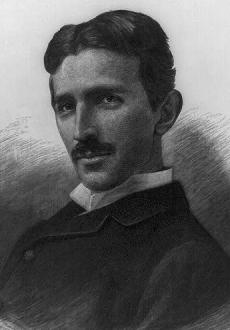A brief history of electricity

Picture: Nikola Tesla (1856–1943) pioneered the alternating current power system most of us use today. Even so, his rival, Thomas Edison (1846–1931), is still popularly remembered as the inventor who gave the world electric power. Photograph by Sarony; engraving by T. Johnson, c.1906, courtesy of US Library of Congress.
- 600 BCE: Greek philosopher Thales of Miletus (c.624–546 BCE) discovered static electricity.
- 1600 CE: English scientist William Gilbert (1544–1603) was the first person to use the word "electricity." He believed electricity was caused by a moving fluid called humor.
- 1733: French scientist Charles du Fay (1698–1739) found that there were two different kinds of static electric charge.
- 1752: American printer, journalist, scientist, and statesman Benjamin Franklin (1706–1790) carried out further experiments and named the two kinds of electric charge "positive" and "negative."
- 1780: Italian biologist Luigi Galvani (1737–1798) touched two pieces of metal to a dead frog's leg and made it jump. This led him to believe electricity is made inside animals' bodies.
- 1785: French scientist Charles Augustin de Coulomb (1736–1806) explored the mysteries of electric fields: the electrically active areas around electric charges.
- 1800: One of Galvani's friends, an Italian physics professor named Alessandro Volta (1745–1827), realized "animal electricity" was made by the metals Galvani had used. After further research, he found out how to make electricity by joining different metals together and invented batteries.
- 1827: German physicist Georg Ohm (1789–1854) found some materials carry electricity better than others and developed the idea of resistance.
- 1820: Danish physicist Hans Christian Oersted (1777–1851) put a compass near an electric cable and discovered that electricity can make magnetism.
- 1821: A French physicist called Andre-Marie Ampère (1775–1836) put two electric cables near to one another, wired them up to a power source, and watched them push one another apart. This showed electricity and magnetism can work together to make a force.
- 1821: Michael Faraday (1791–1867), an English chemist and physicist, developed the first, primitive electric motor.
- 1830s: American physicist Joseph Henry (1797–1879) and British inventor William Sturgeon (1783–1850) independently made the first practical electromagnets and electric motors.
- 1831: Building on his earlier discoveries, Michael Faraday invented the electric generator.
- 1840: Scottish physicist James Prescott Joule (1818–1889) proved that electricity is a kind of energy.
- 1870s: Belgian engineer Zénobe Gramme (1826–1901) made the first large-scale electric generators.
- 1873: James Clerk Maxwell (1831–1879), another British physicist, set out a detailed theory of electromagnetism (how electricity and magnetism work together).
- 1881: The world's first experimental electric power plant opened in Godalming, England.
- 1882: Thomas Edison (1846–1931) built the first large-scale electric power plants in the USA.
- 1890s: Edison's former employee Nikola Tesla (1856–1943) promoted alternating current (AC) electricity, a rival to the direct current (DC) system promoted by Edison. Edison and Tesla battled for supremacy and, although Edison is remembered as the pioneer of electric power, it was Tesla's AC system that ultimately triumphed.
No comments:
Post a Comment